预约演示
更新于:2025-05-16
Cloxacillin Sodium
氯唑西林钠
更新于:2025-05-16
概要
基本信息
在研机构 |
权益机构- |
最高研发阶段批准上市 |
首次获批日期 加拿大 (1963-12-31), |
最高研发阶段(中国)批准上市 |
特殊审评- |
登录后查看时间轴
结构/序列
分子式C19H20ClN3NaO6S |
InChIKeyKNNWTOJBVOKDPC-VICXVTCVSA-N |
CAS号7081-44-9 |
关联
9
项与 氯唑西林钠 相关的临床试验IRCT20220310054247N1
Investigating the effect of a topical gel containing Sumac extract and Cloxacillin on diabetic foot ulcer: a double-blind placebo-controlled trial
开始日期2022-06-05 |
申办/合作机构- |
NCT04141787
Ceftriaxone as Home Intravenous Therapy for Deep-Seated Staphylococcal Infections, a Randomized Non-Inferiority Trial
Patients who are admitted to hospital with serious infections, such as those in bone, joints or spine, require a long course of intravenous (IV) antibiotics. After an initial treatment course in hospital or through a dedicated outpatient antibiotic program many patients can complete their treatment course at home. Such infections are often caused by bacteria called Staphylococci, and currently there are three antibiotic options used routinely. A fourth antibiotic, ceftriaxone, is a promising alternative; it is also effective against Staphylococci, and is more convenient, less costly and easier to give at home, however, it has not been studied thoroughly in a prospective manner. This study will compare ceftriaxone to routinely used antibiotics (cloxacillin, cefazolin or daptomycin) to see if ceftriaxone is equally as safe and efficacious in curing deep-seated Staphylococcal infections in patients receiving home IV antibiotics. Patients with deep-seated infections caused by methicillin-susceptible Staphylococcus aureus (MSSA) or coagulase-negative Staphylococcal species will be randomly assigned home IV treatment with ceftriaxone OR one of the three other antibiotics before leaving the hospital. Patients will then receive usual care from an Infectious Disease physician and Home IV team. The study team will assess whether cure has been achieved by the end of the IV treatment, follow-up at 6 months to see if patients remain infection-free, and record any side-effects of treatment. The overall goal is to determine whether ceftriaxone can be considered non-inferior to usual antibiotic treatment in treating Staphylococcal infections in a home IV setting.
开始日期2019-07-11 |
IRCT20120215009014N272
Effect of using Cloxacillin as an Antibiotic Lock Solution versus placebo on prevention of catheter-associated infection in hemodialysis patients: a single-blind randomized clinical trial
开始日期2019-05-05 |
100 项与 氯唑西林钠 相关的临床结果
登录后查看更多信息
100 项与 氯唑西林钠 相关的转化医学
登录后查看更多信息
100 项与 氯唑西林钠 相关的专利(医药)
登录后查看更多信息
5,213
项与 氯唑西林钠 相关的文献(医药)2025-05-06·ACS Omega
Membrane-Active Peptides Derived from Natural Transmembrane Domains Function as Antibiotic Potentiators
Article
作者: Johnson, Tyler S. ; Deber, Charles M.
Antimicrobial resistance continues to be a prevailing threat to human health worldwide, largely due to the arsenal of resistance mechanisms bacteria have evolved over years of exposure to traditional antibiotics. As an approach to devising therapeutics that can overcome this resistance, we hypothesized that peptides consisting of single transmembrane (TM) segments of membrane proteins may permeabilize bacterial membranes and thereby facilitate access of antimicrobials to their cytoplasmic targets. Using peptides derived from a natural TM helix from the AcrB component of the AcrAB-TolC efflux protein, we found that AcrB TM8 (wild type sequence: KKKK-FL(Abu)LAALYESWSI-NH2) and a "scrambled" analog of identical composition, charge, and overall hydrophobicity (TM8-S: KKKK-FSLEALW(Abu)ISAYL-NH2) (Abu = α-aminobutyric acid), resensitize Escherichia coli to sublethal doses of the antibiotics cloxacillin and nalidixic acid. These peptides induce 50-100% reduction of cell growth compared to bacteria treated with either peptide or antibiotic alone. The molecular basis for peptide-based permeabilization of the bacterial outer and inner membranes that contributes to the observed antibiotic potentiation was studied through several in vitro liposome-based assays and in vivo fluorescence-based assays. The overall results suggest that membrane proteins harbor a wealth of peptide sequences that may function as effective membrane-active peptides for the targeting of difficult-to-treat Gram-negative bacterial infections, and as such, provide valuable guidelines for the design of membrane-active peptides with synergistic antibacterial and antibiotic potentiation activity.
2025-05-01·DIAGNOSTIC MICROBIOLOGY AND INFECTIOUS DISEASE
Performance of two combination disk methods as confirmation for ESBL and AmpC presence in clinical Enterobacterales isolates
Article
作者: Bode, L G M ; Klaassen, C H W ; Zandijk, W H A ; Doornekamp, L ; Goessens, W H F
PURPOSE:
Guidelines recommend the use of a combination disk method (CDM) including cefepime and clavulanic acid as a confirmation method for ESBL detection. However, an alternative CDM containing cloxacillin (combining ceftazidime and cefotaxime with clavulanic acid and/or cloxacillin), is not only able to confirm ESBL presence, but also to provide information about AmpC production. We aim to show non-inferiority of the cloxacillin-CDM compared to the cefepime-CDM.
METHODS:
We collected 102 individual clinical Enterobacterales isolates that were positive in the ESBL screening with the VITEK II. Phenotypic confirmation was performed with a cefepime-CDM and a cloxacillin-CDM (Rosco®). These results were compared with the results of a multiplex ESBL real-time PCR and an in-house developed conventional AmpC PCR.
RESULTS:
Twenty-eight% of the isolates were positive in the ESBL PCR (CTX-M, SHV-2, TEM-3). The results of cefepime-CDM and cloxacillin-CDM were concordant with the ESBL PCR in respectively 99 and 94 %. The cefepime-CDM had a sensitivity of 100 % (95 % confidence interval (CI) 88,1-100) and specificity of 98,6 % (95 % CI 92,6-100). The cloxacillin-CDM had a sensitivity of 96,6 (95 % CI 82,2-99,9) and a specificity of 93,2 % (95 % CI 84,7-97,7). The cloxacillin-CDM in the group I Enterobacterales compared to the AmpC PCR had a sensitivity of 92 % (95 % CI 62-100) and a specificity of 100 % (95 % CI 77-100).
CONCLUSION:
Both cefepime-CDM and cloxacillin-CDM performed well as ESBL confirmation methods. Therefore, we suggest to add the cloxacillin-CDM as an alternative ESBL confirmation method to AMR detection guidelines in clinical settings.
2025-05-01·CLINICAL MICROBIOLOGY AND INFECTION
Cefazolin versus Antistaphylococcal Penicillins for the Treatment of Methicillin-Susceptible Staphylococcus aureus Bacteremia: A Systematic Review and Meta-Analysis
Review
作者: Jager, Nynke G L ; Ghanem-Zoubi, Nesrin ; Lee, Todd C ; Daneman, Nick ; Tong, Steven Y C ; Goodman, Anna L ; Kouijzer, Ilse ; Ong, Sean W X ; Kaasch, Achim J ; McDonald, Emily G ; Davis, Joshua S ; Noutsios, Dean ; Prosty, Connor ; McMullan, Brendan J
BACKGROUND:
There is debate on whether cefazolin or antistaphylococcal penicillins should be the first-line treatment for methicillin-susceptible Staphylococcus aureus (MSSA) bacteremia. Ongoing trials are investigating whether cefazolin is non-inferior to (flu)cloxacillin, but it remains uncertain whether these findings apply to other antistaphylococcal penicillins.
OBJECTIVE:
We conducted a systematic review and meta-analysis comparing cefazolin to each of the individual antistaphylococcal penicillins for MSSA bacteremia.
METHODS:
Data SourcesWe updated a 2019 systematic review but specifically focused on evaluating outcomes by individual antistaphylococcal penicillins.Study Eligibility CriteriaComparative observational studies.ParticipantsPatients with MSSA bacteremia.InterventionsCefazolin versus the antistaphylococcal penicillins.Assessment of Risk of BiasThe risk of bias in non-randomized studies of interventions tool.Methods of Data SynthesisThe primary outcome was 30-day all-cause mortality and we assessed for non-inferiority of cefazolin using a prespecified non-inferiority margin of a pooled odds ratio (OR) <1.2 using raw unadjusted data. Secondary outcomes were 90-day mortality, treatment-related adverse events (TRAEs), discontinuation due to toxicity, and nephrotoxicity.
RESULTS:
No randomized data have been published. 30 observational studies at moderate or high risk of bias were included, which comprised 3869 patients who received cefazolin and 11644 patients who received antistaphylococcal penicillins (flucloxacillin=6721, unspecified=2440, nafcillin=1305, cloxacillin=1258, and oxacillin=120). Cefazolin was associated with a reduced odds of 30-day all-cause mortality (OR=0.73, 95%CI=0.62-0.85) compared to antistaphylococcal penicillins, meeting pre-specified non-inferiority. This effect was consistent versus flucloxacillin (OR=0.92, 95%CI=0.73-1.16), nafcillin (OR=0.58, 95%CI=0.28-1.17), cloxacillin (OR=0.42, 95%CI=0.11-1.58), and oxacillin (OR=0.31, 95%CI=0.03-2.75). Point estimates favored cefazolin for 90-day mortality, TRAEs, nephrotoxicity, and discontinuation due to toxicity overall and in each comparison with individual antistaphylococcal penicillins, except for TRAEs versus cloxacillin.
CONCLUSIONS:
In moderate to low quality observational data, cefazolin was non-inferior for mortality and potentially superior for safety as compared to antistaphylococcal penicillins overall and across most individual comparisons.
16
项与 氯唑西林钠 相关的新闻(医药)2024-09-20
·药闻康策
☝ 点击上方 一键预约 ☝
最新最热的医药健康新闻政策
前九批国家组织药品集中采购品种可替代药品参考监测范围
第一批国家组织药品集中采购中选品种监测范围
序号
集采品种
完全可替代
大部分可替代
一定程度上可替代
1
阿托伐他汀钙口服常释剂型
★辛伐他汀、★匹伐他汀、
普伐他汀、氟伐他汀、洛伐他汀
★瑞舒伐他汀
2
瑞舒伐他汀钙口服常释剂型
★辛伐他汀、★匹伐他汀、
普伐他汀、氟伐他汀、洛伐他汀
★阿托伐他汀
3
氯吡格雷口服常释剂型
噻氯匹定
★替格瑞洛
4
厄贝沙坦口服常释剂型
★奥美沙坦酯、★坎地沙坦酯、★缬沙坦、★替米沙坦、
★氯沙坦、阿利沙坦酯、
阿齐沙坦、美阿沙坦
★赖诺普利、★贝那普利、★依那普利、
★培哚普利、雷米普利、喹那普利、
咪达普利
5
氨氯地平口服常释剂型
★左氨氯地平
★硝苯地平、★非洛地平、拉西地平、
尼群地平、贝尼地平、西尼地平、
马尼地平、尼卡地平、★乐卡地平
6
恩替卡韦口服常释剂型
拉米夫定、★阿德福韦酯、替比夫定
★替诺福韦二吡呋酯、★丙酚替诺福韦、艾米替诺福韦
7
艾司西酞普兰口服常释剂型
★西酞普兰
多塞平、氯米帕明、噻奈普汀、吗氯贝胺、马普替林、
米安色林、瑞波西汀
★氟西汀、★帕罗西汀、伏硫西汀、
★度洛西汀、★舍曲林、氟伏沙明、
安非他酮、曲唑酮、★文拉法辛、
米那普仑、★米氮平、阿戈美拉汀、
阿米替林、圣约翰草提取物
8
帕罗西汀口服常释剂型
多塞平、氯米帕明、噻奈普汀、吗氯贝胺、马普替林、
米安色林、瑞波西汀
★西酞普兰、★艾司西酞普兰、
★氟西汀、伏硫西汀、★度洛西汀、
★舍曲林、氟伏沙明、安非他酮、
曲唑酮、★文拉法辛、米那普仑、
★米氮平、阿戈美拉汀、阿米替林、
圣约翰草提取物
9
奥氮平口服常释剂型
三氟拉嗪、三氟哌多、
五氟利多、洛沙平、硫利达嗪、哌泊塞嗪、氟哌利多
★氨磺必利、★阿立哌唑、★利培酮、
帕利哌酮、★氯氮平、★喹硫平、
布南色林、★鲁拉西酮、齐拉西酮、
舒必利、氯丙嗪、氟哌啶醇、
氟奋乃静、奋乃静、癸氟奋乃静、
硫必利、氯普噻吨
10
头孢呋辛酯口服常释剂型
★头孢克洛、★头孢丙烯
★头孢拉定、★头孢氨苄、头孢羟氨苄、
★头孢克肟、★头孢地尼、头孢他美酯、
头孢妥仑匹酯、头孢泊肟酯
11
利培酮口服常释剂型
三氟拉嗪、三氟哌多、
五氟利多、洛沙平、硫利达嗪、
哌泊塞嗪、氟哌利多
★氨磺必利、★阿立哌唑、★奥氮平、
帕利哌酮、★氯氮平、★喹硫平、
布南色林、★鲁拉西酮、齐拉西酮、
舒必利、氯丙嗪、氟哌啶醇、
氟奋乃静、奋乃静、癸氟奋乃静、
硫必利、氯普噻吨
12
吉非替尼口服常释剂型
埃克替尼、★厄洛替尼
★阿法替尼、达可替尼、奥希替尼、
伏美替尼、阿美替尼
13
福辛普利口服常释剂型
★赖诺普利、★贝那普利、
★依那普利、★培哚普利、
雷米普利、喹那普利、咪达普利
★奥美沙坦酯、★坎地沙坦酯、
★缬沙坦、★替米沙坦、★氯沙坦、
阿利沙坦酯、阿齐沙坦、美阿沙坦
14
厄贝沙坦氢氯噻嗪口服常释剂型
奥美沙坦酯氢氯噻嗪、
★氯沙坦氢氯噻嗪、
替米沙坦氢氯噻嗪、
★缬沙坦氢氯噻嗪、坎地氢噻
15
赖诺普利口服常释剂型
★贝那普利、★依那普利、
★培哚普利、雷米普利、
喹那普利、咪达普利
★福辛普利
16
替诺福韦二吡呋酯口服常释剂型
拉米夫定、★阿德福韦酯、替比夫定
★丙酚替诺福韦、艾米替诺福韦
★恩替卡韦
17
氯沙坦口服常释剂型
阿齐沙坦、美阿沙坦、
★奥美沙坦酯、★坎地沙坦酯、
★缬沙坦、★替米沙坦、
★厄贝沙坦、阿利沙坦酯
★赖诺普利、★贝那普利、★依那普利、
★培哚普利、雷米普利、喹那普利、
咪达普利
18
依那普利口服常释剂型
★贝那普利、★赖诺普利、
★培哚普利、雷米普利、
喹那普利、咪达普利
★福辛普利、★奥美沙坦酯、★缬沙坦、
★坎地沙坦酯、★替米沙坦、★氯沙坦、
阿利沙坦酯、阿齐沙坦、美阿沙坦
19
左乙拉西坦口服常释剂型
奥卡西平、丙戊酸镁、丙戊酸钠、
卡马西平、拉莫三嗪、托吡酯
20
伊马替尼口服常释剂型
氟马替尼
尼洛替尼、达沙替尼
21
孟鲁司特口服常释剂型
普仑司特、扎鲁司特
22
蒙脱石口服散剂
23
培美曲塞注射剂
24
氟比洛芬酯注射剂
双氯芬酸、★布洛芬、★帕瑞昔布、
吡罗昔康、★酮咯酸氨丁三醇
25
右美托咪定注射剂
第二批国家组织药品集中采购中选品种监测范围
序号
集采品种
完全可替代
大部分可替代
一定程度上可替代
1
阿比特龙口服常释剂型
氟他胺、★比卡鲁胺、恩扎卢胺
2
阿德福韦酯口服常释剂型
拉米夫定、替比夫定
★替诺福韦二吡呋酯、★丙酚替诺福韦、艾米替诺福韦、★恩替卡韦
3
阿卡波糖口服常释剂型
伏格列波糖、★米格列醇
4
阿莫西林口服常释剂型
青霉素V、氨苄西林、
苯唑西林、氯唑西林
5
阿奇霉素口服常释剂型
红霉素、琥乙红霉素、
环酯红霉素、★罗红霉素
地红霉素、泰利霉素、依托红霉、
★克拉霉素
6
安立生坦片
波生坦
马昔腾坦、利奥西呱
7
奥美沙坦酯口服常释剂型
★氯沙坦、阿利沙坦酯
★坎地沙坦酯、★缬沙坦、★替米沙坦、★厄贝沙坦、阿齐沙坦、美阿沙坦
★福辛普利、★贝那普利、★赖诺普利、
★培哚普利、雷米普利、喹那普利、
咪达普利
8
比索洛尔口服常释剂型
★美托洛尔、卡维地洛、
贝凡洛尔、阿罗洛尔、
塞利洛尔
阿替洛尔、★普萘洛尔、尼群洛尔
9
对乙酰氨基酚口服常释剂型
★布洛芬、萘普生
双氯芬酸、★洛索洛芬、★美洛昔康、
★依托考昔、★塞来昔布、艾瑞昔布
10
多奈哌齐口服常释剂型
加兰他敏、卡巴拉汀、★美金刚
11
氟康唑口服常释剂型
★伏立康唑、伊曲康唑、泊沙康唑、
艾沙康唑
12
福多司坦口服常释剂型
羧甲司坦、乙酰半胱氨酸
厄多司坦、美司坦、★氨溴索、
★溴己新、桉柠蒎
13
格列美脲口服常释剂型
格列本脲
★格列齐特
格列喹酮、★格列吡嗪
14
甲硝唑口服常释剂型
★替硝唑、★奥硝唑、
塞克硝唑
左奥硝唑
15
聚乙二醇口服散剂
复方聚乙二醇电解质Ⅰ、
复方聚乙二醇电解质Ⅱ、
复方聚乙二醇电解质Ⅲ、
复方聚乙二醇电解质Ⅳ、硫酸镁、乳果糖
16
坎地沙坦酯口服常释剂型
★氯沙坦、阿利沙坦酯
阿齐沙坦、美阿沙坦、
★奥美沙坦酯、★缬沙坦、
★替米沙坦、
★厄贝沙坦、阿齐沙坦酯
★福辛普利、★贝那普利、★赖诺普利、
★培哚普利、雷米普利、喹那普利、
咪达普利
17
克林霉素口服常释剂型
克林霉素棕榈酸酯、
克林霉素磷酸酯、林可霉素
18
铝碳酸镁咀嚼片
铝镁加
磷酸铝凝胶、复方氢氧化铝
19
美洛昔康口服常释剂型
吡罗昔康
氯诺昔康、★塞来昔布、★依托考昔、
艾瑞昔布、双氯芬酸、★洛索洛芬
20
莫西沙星口服常释剂型
吡哌酸、氧氟沙星、
★诺氟沙星
★左氧氟沙星、
★环丙沙星、洛美沙星、
氟罗沙星、司帕沙星
吉米沙星、奈诺沙星、加诺沙星、安妥沙星
21
曲美他嗪缓释控释剂型
22
索利那新口服常释剂型
托特罗定、奥昔布宁
23
他达拉非片
★西地那非、伐地那非
24
特拉唑嗪口服常释剂型
阿夫唑嗪、多沙唑嗪
★坦索罗辛、赛洛多辛
25
替吉奥口服常释剂型
氟尿嘧啶
替加氟、★卡培他滨、曲氟尿苷替匹嘧啶
26
头孢氨苄口服常释剂型
★头孢拉定、头孢羟氨苄
★头孢呋辛酯、★头孢克洛、★头孢丙烯、★头孢克肟、★头孢地尼、头孢妥仑匹酯、头孢泊肟酯、头孢他美酯
27
头孢拉定口服常释剂型
★头孢氨苄、头孢羟氨苄
★头孢呋辛酯、★头孢克洛、★头孢丙烯、★头孢地尼、头孢妥仑匹酯、★头孢克肟、头孢泊肟酯、头孢他美酯
28
辛伐他汀口服常释剂型
★匹伐他汀、普伐他汀、
氟伐他汀、洛伐他汀
★瑞舒伐他汀、★阿托伐他汀
29
异烟肼口服常释剂型
30
吲达帕胺口服常释剂型
氢氯噻嗪、★呋塞米、
★托拉塞米
美托拉宗、螺内酯、阿米洛利、布美他尼
31
注射用紫杉醇(白蛋白结合型)
紫杉醇脂质体、
★紫杉醇
★多西他赛
32
左西替利嗪口服常释剂型
赛庚啶、氯苯那敏、
★西替利嗪
苯海拉明、★异丙嗪、★氯雷他定、
★地氯雷他定、卢帕他定、★奥洛他定、
非索非那定、阿伐斯汀、咪唑斯汀、
★依巴斯汀、★贝他斯汀、依美斯汀
第三批国家组织药品集中采购中选品种监测范围
序号
集采品种
完全可替代
大部分可替代
一定程度上可替代
1
阿那曲唑口服常释剂型
★来曲唑、依西美坦
2
阿哌沙班口服常释剂型
华法林
★利伐沙班、艾多沙班、★达比加群酯
3
阿扎胞苷注射剂
4
氨基葡萄糖口服常释剂型
5
氨溴索口服常释剂型
羧甲司坦、乙酰半胱氨酸
★福多司坦、厄多司坦、美司坦 、
★溴己新、桉柠蒎
6
奥氮平口腔崩解片
三氟拉嗪、三氟哌多、五氟利多、
洛沙平、硫利达嗪、哌泊塞嗪、
氟哌利多
★氨磺必利、★阿立哌唑、★利培酮、
帕利哌酮、★氯氮平、★喹硫平、布南色林、
★鲁拉西酮、齐拉西酮、舒必利、氯丙嗪、
氟哌啶醇、氟奋乃静、奋乃静、癸氟奋乃静、
硫必利、氯普噻吨
7
奥美拉唑口服常释剂型
★艾司奥美拉唑
★泮托拉唑、兰索拉唑、雷贝拉唑、艾普拉唑
8
布洛芬缓释控释剂型
右布洛芬、萘普生
★对乙酰氨基酚、★美洛昔康、双氯芬酸、
★塞来昔布、★依托考昔、芬布芬、洛索洛芬
9
布洛芬颗粒剂
右布洛芬、萘普生
★对乙酰氨基酚、★美洛昔康、双氯芬酸、
★塞来昔布、★依托考昔、芬布芬、洛索洛芬
10
地氯雷他定口服常释剂型
赛庚啶、
氯苯那敏、
★氯雷他定
★异丙嗪、苯海拉明、非索非那定、
卢帕他定、★奥洛他定、★西替利嗪、
★左西替利嗪、阿伐斯汀、咪唑斯汀、
★依巴斯汀、★贝他斯汀、依美斯汀
11
多潘立酮口服常释剂型
★莫沙必利、氯波必利、伊托必利
12
二甲双胍缓释控释剂型
苯乙双胍
二甲双胍常释制剂
13
二甲双胍口服常释剂型
苯乙双胍
二甲双胍缓释控释剂型
14
非布司他口服常释剂型
别嘌醇、苯溴马隆
15
非那雄胺口服常释剂型(5mg)
爱普列特
★度他雄胺
16
非那雄胺口服常释剂型(1mg)
17
氟西汀口服常释剂型
多塞平、氯米帕明、噻奈普汀、
吗氯贝胺、马普替林、米安色林、
瑞波西汀
★西酞普兰、★艾司西酞普兰、★帕罗西汀、
伏硫西汀、★度洛西汀、★舍曲林、
氟伏沙明、安非他酮、曲唑酮、★文拉法辛、
米那普仑、★米氮平、阿戈美拉汀、阿米替林、
圣约翰草提取物
18
枸橼酸西地那非片
★他达拉非、伐地那非
19
甲钴胺口服常释剂型
维生素B12、腺苷钴胺
20
卡培他滨口服常释剂型
氟尿嘧啶
替加氟、★替吉奥、曲氟尿苷替匹嘧啶
21
卡托普利口服常释剂型
★福辛普利、★赖诺普利、★培哚普利、
★依那普利、雷米普利、喹那普利、
★贝那普利、咪达普利
22
喹硫平口服常释剂型
三氟拉嗪、三氟哌多、五氟利多、
洛沙平、硫利达嗪、哌泊塞嗪、
氟哌利多
★奥氮平、★利培酮、帕利哌酮、★阿立哌唑、★氨磺必利、布南色林、★鲁拉西酮、齐拉西酮、舒必利、氟哌啶醇、氯丙嗪、氟奋乃静、奋乃静、癸氟奋乃静、硫必利、氯普噻吨
23
来曲唑口服常释剂型
★阿那曲唑、依西美坦
24
氯氮平口服常释剂型
三氟拉嗪、三氟哌多、五氟利多、
洛沙平、硫利达嗪、哌泊塞嗪、
氟哌利多
★奥氮平、★利培酮、帕利哌酮、
★阿立哌唑、★氨磺必利、★喹硫平、
布南色林、★鲁拉西酮、齐拉西酮、舒必利、氟哌啶醇、氯丙嗪、氟奋乃静、奋乃静、
癸氟奋乃静、硫必利、氯普噻吨
25
美金刚口服常释剂型
★多奈哌齐、利斯的明、加兰他敏、
卡巴拉汀、丁苯酞、甘露特钠
26
孟鲁司特咀嚼片
普仑司特、扎鲁司特
27
孟鲁司特颗粒剂
普仑司特、扎鲁司特
28
匹伐他汀口服常释剂型
★辛伐他汀
普伐他汀、氟伐他汀、洛伐他汀、
★阿托伐他汀、★瑞舒伐他汀
29
普芦卡必利口服常释剂型
30
曲美他嗪口服常释剂型
31
塞来昔布口服常释剂型
艾瑞昔布
★依托考昔、芬布芬、右布洛芬、★布洛芬、洛索洛芬
32
舍曲林口服常释剂型
多塞平、氯米帕明、噻奈普汀、
吗氯贝胺、马普替林、米安色林、
瑞波西汀
★西酞普兰、★艾司西酞普兰、★氟西汀、
★帕罗西汀、伏硫西汀、★度洛西汀、
氟伏沙明、安非他酮、曲唑酮、★文拉法辛、
米那普仑、★米氮平、阿戈美拉汀、阿米替林、
圣约翰草提取物
33
坦洛新(坦索罗辛) 缓释控释剂型
★特拉唑嗪、阿夫唑嗪、多沙唑嗪、赛洛多辛
34
碳酸氢钠口服常释剂型
35
替格瑞洛口服常释剂型
噻氯匹啶
★氯吡格雷
36
托法替布口服常释剂型
巴瑞替尼、乌帕替尼
37
维格列汀口服常释剂型
★沙格列汀、西格列汀、阿格列汀、利格列汀
38
维生素B6口服常释剂型
39
西酞普兰口服常释剂型
★艾司西酞普兰、多塞平、
氯米帕明、噻奈普汀、吗氯贝胺、
马普替林、米安色林、瑞波西汀
★氟西汀、★帕罗西汀、伏硫西汀、
★度洛西汀、★舍曲林、氟伏沙明、
安非他酮、曲唑酮、★文拉法辛、米那普仑、★米氮平、阿戈美拉汀、阿米替林、
圣约翰草提取物
40
西替利嗪口服常释剂型
赛庚啶、氯苯那敏
★左西替利嗪
苯海拉明、★异丙嗪、★氯雷他定、
★地氯雷他定、非索非那定、卢帕他定、
★奥洛他定、阿伐斯汀、咪唑斯汀、
★依巴斯汀、★贝他斯汀、依美斯汀
41
缬沙坦口服常释剂型
★氯沙坦、
阿利沙坦酯
坎地沙坦、依普沙坦、★厄贝沙坦
★奥美沙坦、★替米沙坦、阿齐沙坦、
美阿沙坦
42
盐酸达泊西汀片
43
依托考昔口服常释剂型
艾瑞昔布
★塞来昔布、芬布芬、右布洛芬
44
乙胺丁醇口服常释剂型
氨硫脲、对氨基水杨酸
45
右佐匹克隆口服常释剂型
佐匹克隆
唑吡坦、扎来普隆、艾司唑仑
46
左乙拉西坦口服液体剂
奥卡西平、丙戊酸镁、丙戊酸钠、卡马西平、拉莫三嗪、托吡酯
47
左乙拉西坦注射用浓溶液
苯巴比妥、丙戊酸钠
48
阿莫西林颗粒剂
青霉素V、氨苄西林
苯唑西林、氯唑西林
49
利奈唑胺口服常释剂型
康替唑胺
50
莫西沙星氯化钠注射剂
氧氟沙星、
诺氟沙星
环丙沙星、★左氧氟沙星、
洛美沙星、帕珠沙星、依诺沙星、
培氟沙星、氟罗沙星、加替沙星
奈诺沙星
51
左氧氟沙星滴眼剂
诺氟沙星滴眼液、氧氟沙星滴眼液、洛美沙星滴眼液、环丙沙星滴眼液
★莫西沙星滴眼液、加替沙星滴眼液
52
环丙沙星口服常释剂型
吡哌酸、
★诺氟沙星
★莫西沙星、奈诺沙星、加诺沙星、
西他沙星、依诺沙星、培氟沙星、氟罗沙星、
氧氟沙星、★左氧氟沙星、洛美沙星、
司帕沙星、加替沙星、吉米沙星、安妥沙星
53
头孢地尼口服常释剂型
★头孢克肟、头孢妥仑匹酯、
头孢泊肟酯、头孢他美酯
★头孢呋辛酯、★头孢克洛、★头孢丙烯
54
头孢克洛口服常释剂型
★头孢呋辛酯、★头孢丙烯
★头孢拉定、★头孢氨苄、头孢羟氨苄、
★头孢克肟、★头孢地尼、头孢妥仑匹酯、
头孢泊肟酯、头孢他美酯
55
克拉霉素口服常释剂型
红霉素、琥乙红霉素、环酯红霉素、依托红霉素、★罗红霉素
★阿奇霉素、地红霉素、泰利霉素
第四批国家组织药品集中采购中选品种监测范围
序号
集采品种
完全可替代
大部分可替代
一定程度上可替代
1
恩曲他滨替诺福韦口服常释剂型
齐多夫定、司他夫定、阿巴卡韦、
替诺福韦、奈韦拉平、依非韦伦、
茚地那韦、利托那韦、
洛匹那韦利托那韦、达芦那韦考比司他、
拉替拉韦、多替拉韦
2
多索茶碱注射剂
氨茶碱
二羟丙茶碱
3
氨溴索注射剂
乙酰半胱氨酸、★溴己新
4
沙丁胺醇吸入剂
左沙丁胺醇、★特布他林
5
氨磺必利口服常释剂型
三氟拉嗪、三氟哌多、五氟利多、
洛沙平、硫利达嗪、哌泊塞嗪、
氟哌利多
★奥氮平、★利培酮、帕利哌酮、
★氯氮平、★阿立哌唑、★喹硫平、
布南色林、★鲁拉西酮、齐拉西酮、
舒必利、氟哌啶醇、氯丙嗪、氟奋乃静、
奋乃静、癸氟奋乃静、硫必利、氯普噻吨
6
度洛西汀口服常释剂型
多塞平、氯米帕明、噻奈普汀、
吗氯贝胺、马普替林、米安色林、
瑞波西汀
★西酞普兰、★艾司西酞普兰、
★氟西汀、★帕罗西汀、伏硫西汀、
★舍曲林、氟伏沙明、安非他酮、
曲唑酮、★文拉法辛、米那普仑、
★米氮平、阿戈美拉汀、阿米替林、
圣约翰草提取物
7
喹硫平缓释控释剂型
三氟拉嗪、三氟哌多、五氟利多、
洛沙平、硫利达嗪、哌泊塞嗪、
氟哌利多
★氨磺必利、★奥氮平、★利培酮、
帕利哌酮、★阿立哌唑、布南色林、
★鲁拉西酮、齐拉西酮、舒必利、
氟哌啶醇、氯丙嗪、氟奋乃静、奋乃静、
癸氟奋乃静、硫必利、氯普噻吨
8
吡嗪酰胺口服常释剂型
9
诺氟沙星口服常释剂型
部分喹诺酮、小檗碱
10
头孢丙烯口服常释剂型
★头孢呋辛酯、★头孢克洛
★头孢拉定、★头孢氨苄、头孢羟氨苄、★头孢地尼、★头孢克肟、
头孢妥仑匹酯、头孢泊肟酯、头孢他美酯
11
左氧氟沙星口服常释剂型
吡哌酸、氧氟沙星、
★诺氟沙星
★环丙沙星、洛美沙星、
依诺沙星、培氟沙星、氟罗沙星、
司帕沙星、加替沙星、吉米沙星、
安妥沙星
★莫西沙星、奈诺沙星、加诺沙星、
西他沙星
12
伏立康唑口服常释剂型
★氟康唑、伊曲康唑、泊沙康唑、
艾沙康唑
13
特比萘芬口服常释剂型
14
丙泊酚中/长链脂肪乳注射剂
丙泊酚
美索比妥、羟丁酸钠、
氯胺酮、依托咪酯、咪达唑仑、
艾司氯胺酮
15
氯雷他定口服常释剂型
赛庚啶、氯苯那敏
苯海拉明、★异丙嗪、★地氯雷他定、
★奥洛他定、卢帕他定、非索非那定、
★左西替利嗪、★西替利嗪、阿伐斯汀、
咪唑斯汀、★依巴斯汀、★贝他斯汀、
比拉斯汀
16
恩格列净口服常释剂型
达格列净、★卡格列净、
艾托格列净
17
卡格列净口服常释剂型
达格列净、★恩格列净、
艾托格列净
18
格列齐特缓释控释剂型
★格列美脲、格列本脲、消渴丸
格列喹酮、★格列吡嗪
19
那格列奈口服常释剂型
米格列奈、★瑞格列奈
20
瑞格列奈口服常释剂型
米格列奈、★那格列奈
21
羟苯磺酸钙口服常释剂型
22
普拉克索缓释控释剂型
苯海索、金刚烷胺、多巴丝肼、
左旋多巴、卡左双多巴、司来吉兰、
恩他卡朋、雷沙吉兰
23
普拉克索口服常释剂型
苯海索、金刚烷胺、多巴丝肼、
左旋多巴、卡左双多巴、司来吉兰、
恩他卡朋、雷沙吉兰
24
加巴喷丁口服常释剂型
★普瑞巴林、卡马西平
25
布洛芬口服常释剂型
右布洛芬、芬布芬
萘普生、★美洛昔康、双氯芬酸、★塞来昔布、★依托考昔、
★洛索洛芬、氟比洛芬、艾瑞昔布
★对乙酰氨基酚
26
布洛芬注射剂
★帕瑞昔布、★氟比洛芬酯
27
洛索洛芬口服常释剂型
★布洛芬
萘普生、★美洛昔康、双氯芬酸、★塞来昔布、★依托考昔、
氟比洛芬、艾瑞昔布
★对乙酰氨基酚
28
帕瑞昔布注射剂
★布洛芬、★氟比洛芬酯
29
普瑞巴林口服常释剂型
★加巴喷丁、卡马西平
30
艾司奥美拉唑口服常释剂型
★奥美拉唑
兰索拉唑、艾普拉唑
★泮托拉唑、雷贝拉唑
31
莫沙必利口服常释剂型
氯波必利、伊托必利、★多潘立酮、
甲氧氯普胺
32
泮托拉唑口服常释剂型
★奥美拉唑、★艾司奥美拉唑、
兰索拉唑、雷贝拉唑、艾普拉唑
33
泮托拉唑注射剂
★奥美拉唑、★艾司奥美拉唑、
★兰索拉唑、雷贝拉唑、艾普拉唑
34
替格瑞洛口服常释剂型
噻氯匹啶
★氯吡格雷
35
比伐芦定注射剂
36
培哚普利口服常释剂型
★福辛普利、★赖诺普利、
雷米普利、喹那普利、
★贝那普利、咪达普利、
★依那普利
37
替米沙坦口服常释剂型
★氯沙坦、阿利沙坦酯
★缬沙坦、★坎地沙坦酯、
★厄贝沙坦、阿齐沙坦、
美阿沙坦、★奥美沙坦酯
38
缬沙坦氨氯地平口服常释剂型
奥美沙坦酯氨氯地平
39
缬沙坦氢氯噻嗪口服常释剂型
★氯沙坦氢氯噻嗪
★厄贝沙坦氢氯噻嗪、坎地氢噻、替米沙坦氢氯噻嗪
奥美沙坦酯氢氯噻嗪
40
奥洛他定滴眼剂
吡嘧司特滴眼液、萘非滴眼液、
色甘酸钠滴眼液
41
玻璃酸钠滴眼剂(0.1%)
聚乙二醇滴眼液、
羧甲基纤维素钠滴眼液(0.5%)
42
玻璃酸钠滴眼剂(0.3%)
聚乙二醇滴眼液、
羧甲基纤维素钠滴眼液(1%)
43
替莫唑胺口服常释剂型
44
硼替佐米注射剂
卡非佐米
45
索拉非尼口服常释剂型
瑞戈非尼、仑伐替尼、培唑帕尼、
依维莫司、去甲斑蝥素、斑蝥酸钠
第五批国家组织药品集中采购中选品种监测范围
序号
集采品种
完全可替代
大部分可替代
一定程度上可替代
1
ω-3鱼油中/长链脂肪乳注射液
多种油脂肪乳(C6-24)
结构脂肪乳(C6-24)、脂肪乳(C14-24)、
中/长链脂肪乳(C6-24)、
中/长链脂肪乳(C8-24)、
中/长链脂肪乳(C8-24Ve)、长链脂肪乳(OO)
2
阿法骨化醇口服常释剂型
★骨化三醇、维生素D
艾地骨化醇
3
阿立哌唑口服常释剂型
三氟拉嗪、三氟哌多、五氟利多、
洛沙平、硫利达嗪、哌泊塞嗪、
氟哌利多
★氨磺必利、★奥氮平、★利培酮、
帕利哌酮、★喹硫平、布南色林、
★鲁拉西酮、齐拉西酮、舒必利、氟哌啶醇、氯丙嗪、氟奋乃静、奋乃静、癸氟奋乃静、
硫必利、氯普噻吨
4
阿昔洛韦口服常释剂型
泛昔洛韦、伐昔洛韦
5
艾司奥美拉唑注射剂
★奥美拉唑
★兰索拉唑、艾普拉唑
★泮托拉唑、雷贝拉唑
6
奥洛他定口服常释剂型
赛庚啶、氯苯那敏
苯海拉明、★异丙嗪、★氯雷他定、
★地氯雷他定、卢帕他定、非索非那定、
★左西替利嗪、★西替利嗪、阿伐斯汀、
咪唑斯汀、★依巴斯汀、依美斯汀、
★贝他斯汀
7
奥沙利铂注射剂
顺铂、卡铂、洛铂、奈达铂
8
贝那普利口服常释剂型
★赖诺普利、★培哚普利、
★依那普利、雷米普利、
喹那普利、咪达普利
★福辛普利
9
贝他斯汀口服常释剂型
赛庚啶、氯苯那敏
阿伐斯汀、咪唑斯汀、
★依巴斯汀、依美斯汀
苯海拉明、★异丙嗪、★氯雷他定、
★地氯雷他定、卢帕他定、★奥洛他定、
非索非那定、★左西替利嗪、★西替利嗪
10
苯磺顺阿曲库铵注射剂
阿曲库铵
★罗库溴铵、维库溴铵
11
比卡鲁胺口服常释剂型
氟他胺
恩扎鲁胺
12
达比加群酯口服常释剂型
★阿哌沙班
★利伐沙班、艾多沙班、华法林
13
单硝酸异山梨酯缓释控释剂型
硝酸异山梨酯
14
地西他滨注射剂
15
碘海醇注射剂
碘比醇、碘佛醇、碘普罗胺、
★碘克沙醇、★碘帕醇、
碘美普尔、复方泛影葡胺
16
碘克沙醇注射剂
碘比醇、碘佛醇、碘普罗胺、
★碘海醇、★碘帕醇、碘美普尔、复方泛影葡胺
17
度他雄胺软胶囊
爱普列特、★非那雄胺
18
多西他赛注射剂
★紫杉醇、紫杉醇脂质体
★紫杉醇(白蛋白结合型)
19
法舒地尔注射剂
尼莫地平
20
复方异丙托溴铵吸入剂
★异丙托溴铵、噻托溴铵、格隆溴铵
21
格列吡嗪缓释控释剂型
★格列美脲、格列本脲、
★格列齐特、消渴丸
格列喹酮、★格列吡嗪(常释剂型)
22
格列吡嗪口服常释剂型
格列喹酮
★格列美脲、格列本脲、★格列齐特、
消渴丸、★格列吡嗪(控释剂型)
23
格隆溴铵注射液
阿托品、东莨菪碱
24
更昔洛韦注射剂
膦甲酸、缬★更昔洛韦
25
枸橼酸氢钾钠颗粒
26
吉西他滨注射剂
27
兰索拉唑注射剂
★泮托拉唑、雷贝拉唑、★奥美拉唑、
艾普拉唑、★艾司奥美拉唑
28
乐卡地平口服常释剂型
★硝苯地平、拉西地平、尼群地平、
贝尼地平、西尼地平、马尼地平、尼卡地平、
★氨氯地平、★左氨氯地平、★非洛地平
29
利伐沙班口服常释剂型
★阿哌沙班
艾多沙班、★达比加群酯、华法林
30
硫辛酸注射剂
31
罗哌卡因注射剂
布比卡因、★左布比卡因、★利多卡因、
丁卡因、普鲁卡因、氯普鲁卡因
32
氯化钾缓释控释剂型
枸橼酸钾
33
美托洛尔口服常释剂型
贝凡洛尔、塞利洛尔、尼群洛尔
阿替洛尔、★普萘洛尔、★比索洛尔
34
米格列醇口服常释剂型
★阿卡波糖、伏格列波糖
35
米索前列醇口服常释剂型
36
帕洛诺司琼注射剂
托烷司琼、★昂丹司琼、格拉司琼、阿扎司琼、多拉司琼、雷莫司琼
37
沙格列汀口服常释剂型
★维格列汀、西格列汀、阿格列汀
利格列汀
38
文拉法辛缓释控释剂型
多塞平、氯米帕明、噻奈普汀、
吗氯贝胺、马普替林、米安色林、
瑞波西汀
★西酞普兰、★艾司西酞普兰、★氟西汀、
★帕罗西汀、伏硫西汀、★度洛西汀、
★舍曲林、氟伏沙明、安非他酮、曲唑酮、
米那普仑、★米氮平、阿戈美拉汀、阿米替林、
圣约翰草提取物
39
西那卡塞口服常释剂型
40
胸腺法新注射剂
胸腺肽、胸腺五肽
41
异丙嗪口服常释剂型
苯海拉明、赛庚啶、氯苯那敏
42
异丙托溴铵吸入剂
★复方异丙托溴铵、噻托溴铵
43
脂肪乳氨基酸葡萄糖注射剂
中长链脂肪乳/氨基酸(16)/葡萄糖(16%)
脂肪乳氨基酸(17)葡萄糖(19%)
10%脂肪乳(OO)/5.5%氨基酸(15)/葡萄糖(20%)、脂肪乳(10%)/氨基酸(15)/葡萄糖(20%)
44
中/长链脂肪乳(C8~24 Ve)注射剂
中/长链脂肪乳(C8~24)、中/长链脂肪乳(C6~24)
★ω-3鱼油中/长链脂肪乳、
多种油脂肪乳(C6~24)、结构脂肪乳(C6-24)、
长链脂肪乳(OO)、脂肪乳(C14-24)
45
注射用盐酸苯达莫司汀
卡莫司汀
46
紫杉醇注射剂
★多西他赛、紫杉醇脂质体
★紫杉醇(白蛋白结合型)
47
阿奇霉素注射剂
红霉素
★克拉霉素
48
布地奈德吸入剂
氟替卡松、倍氯米松
49
氟康唑注射剂
★伏立康唑、泊沙康唑、伊曲康唑、艾沙康唑
50
利奈唑胺葡萄糖注射剂
替考拉宁、万古霉素
51
莫西沙星滴眼剂
★左氧氟沙星滴眼液、
诺氟沙星滴眼液、
氧氟沙星滴眼液、
洛美沙星滴眼液、
环丙沙星滴眼液、
加替沙星滴眼液
52
替硝唑口服常释剂型
★甲硝唑
★奥硝唑、塞克硝唑、左奥硝唑
53
头孢呋辛注射剂
头孢替安、头孢孟多、头孢尼西
★头孢唑林、头孢拉定、头孢硫脒、
头孢噻吩、★头孢曲松、★头孢他啶、
头孢噻肟、头孢哌酮、头孢匹胺、头孢甲肟、
头孢唑肟、★头孢地嗪
54
头孢曲松注射剂
头孢噻肟、头孢匹胺、头孢甲肟、
头孢唑肟、★头孢地嗪
★头孢呋辛、头孢替安、头孢孟多、
头孢尼西、★头孢吡肟、头孢匹罗、
头孢噻利、头孢哌酮、★头孢他啶
55
头孢他啶注射剂
★头孢曲松、头孢噻肟、
头孢哌酮、头孢匹胺、头孢甲肟、
头孢唑肟、★头孢地嗪
★头孢吡肟、头孢匹罗、头孢噻利
56
头孢唑林注射剂
头孢拉定、头孢硫脒、头孢噻吩
头孢替安、头孢孟多、★头孢呋辛、头孢尼西
57
左氧氟沙星注射剂
氧氟沙星、诺氟沙星
洛美沙星、依诺沙星、培氟沙星、
氟罗沙星、加替沙星
★莫西沙星、奈诺沙星、帕珠沙星、环丙沙星
第七批国家组织药品集中采购品种可替代药品参考监测范围
序号
集采品种
完全可替代
大部分可替代
一定程度上可替代
1
阿法替尼口服常释剂型
★厄洛替尼、埃克替尼、
★吉非替尼、达可替尼
奥希替尼、伏美替尼、阿美替尼
2
阿立哌唑口腔崩解片
三氟拉嗪、三氟哌多、五氟利多、
洛沙平、硫利达嗪、哌泊塞嗪、
氟哌利多
★氨磺必利、★奥氮平、★利培酮、帕利哌酮、
★喹硫平、布南色林、★鲁拉西酮、齐拉西酮、
舒必利、氟哌啶醇、氯丙嗪、氟奋乃静、奋乃静、
癸氟奋乃静、硫必利、氯普噻吨
3
昂丹司琼注射剂
托烷司琼、格拉司琼、阿扎司琼、多拉司琼、雷莫司琼
★帕洛诺司琼
4
奥美拉唑注射剂
★艾司奥美拉唑
★兰索拉唑、艾普拉唑、★泮托拉唑、雷贝拉唑
5
奥曲肽注射剂
★生长抑素
兰瑞肽
6
奥司他韦口服常释剂型
阿比多尔、
法维拉韦、玛巴洛沙韦
7
奥硝唑口服常释剂型
★甲硝唑
★替硝唑、塞克硝唑、左奥硝唑
8
吡格列酮口服常释剂型
罗格列酮
9
丙酚替诺福韦口服常释剂型
★阿德福韦酯、
拉米夫定、
替比夫定
★替诺福韦二吡呋酯、艾米替诺福韦
10
醋酸钙口服常释剂型
碳酸钙
司维拉姆、碳酸镧
11
单硝酸异山梨酯口服常释剂型
硝酸异山梨酯
12
碘帕醇注射剂
★碘海醇、碘比醇、碘佛醇、
碘普罗胺、复方泛影葡胺
碘克沙醇
13
厄洛替尼口服常释剂型
★吉非替尼、埃克替尼
★阿法替尼、达可替尼、奥希替尼、伏美替尼、
阿美替尼
14
二甲双胍维格列汀口服常释剂型
西格列汀二甲双胍、沙格列汀二甲双胍
15
氟桂利嗪口服常释剂型
桂利嗪
16
氟哌噻吨美利曲辛口服常释剂型
多塞平、马普替林、氯米帕明、噻奈普汀、
吗氯贝胺、瑞波西汀、阿米替林
17
磺达肝癸钠注射剂
18
甲磺酸仑伐替尼胶囊
★索拉非尼、瑞戈非尼
19
甲泼尼龙口服常释剂型
20
甲泼尼龙注射剂
21
咖啡因注射剂
22
克林霉素磷酸酯注射剂
★克林霉素、林可霉素
23
拉考沙胺口服常释剂型
奥卡西平、卡马西平
24
来氟米特口服常释剂型
25
利多卡因注射剂
布比卡因、★左布比卡因、丁卡因、普鲁卡因、
氯普鲁卡因
26
罗红霉素口服常释剂型
红霉素、琥乙红霉素、
环酯红霉素、依托红霉素
地红霉素、★克拉霉素、★阿奇霉素
27
罗库溴铵注射剂
维库溴铵
★顺阿曲库铵、阿曲库铵
28
吗替麦考酚酯口服常释剂型
麦考酚钠
29
美罗培南注射剂
★比阿培南
厄他培南、亚胺培南西司他丁
30
美托洛尔缓释剂型
贝凡洛尔、塞利洛尔、尼群洛尔
阿替洛尔、★普萘洛尔、★比索洛尔
31
米卡芬净注射剂
卡泊芬净
32
米力农注射剂
氨力农
33
帕立骨化醇注射剂
34
帕洛诺司琼注射剂
托烷司琼、
★昂丹司琼、
格拉司琼、
阿扎司琼、
多拉司琼、
雷莫司琼
35
普萘洛尔口服常释剂型
★美托洛尔、阿替洛尔、贝凡洛尔、塞利洛尔、
尼群洛尔
36
舒尼替尼口服常释剂型
培唑帕尼
索凡替尼、★索拉非尼、瑞戈非尼、★伊马替尼
37
特布他林吸入剂
★沙丁胺醇、左沙丁胺醇
38
替加环素注射剂
无
无
奥马环素、依拉环素
39
替罗非班注射剂型
★依替巴肽
40
头孢吡肟注射剂型
头孢匹罗
★头孢曲松、★头孢他啶、头孢噻肟、头孢哌酮、
头孢甲肟、头孢唑肟、头孢匹胺、★头孢地嗪
41
头孢克洛口服液体剂
★头孢呋辛酯、★头孢丙烯
★头孢拉定、★头孢氨苄、头孢羟氨苄、
★头孢地尼、★头孢克肟、头孢妥仑匹酯、
头孢泊肟酯、头孢他美酯
42
头孢克肟颗粒剂
★头孢地尼、头孢妥仑匹酯、
头孢泊肟酯、头孢他美酯
★头孢拉定、★头孢氨苄、头孢羟氨苄、
★头孢呋辛酯、★头孢丙烯
43
头孢克肟口服常释剂型
★头孢地尼、头孢妥仑匹酯、
头孢泊肟酯、头孢他美酯
★头孢拉定、★头孢氨苄、头孢羟氨苄、
★头孢呋辛酯、★头孢丙烯
44
头孢美唑注射剂型
★头孢西丁、★头孢米诺
45
头孢米诺注射剂型
★头孢西丁、★头孢美唑
46
硝苯地平缓释剂型
★硝苯地平控释剂型
拉西地平、尼群地平、贝尼地平、西尼地平、
马尼地平、尼卡地平、★乐卡地平
47
硝苯地平控释剂型
★硝苯地平缓释剂型
拉西地平、尼群地平、贝尼地平、西尼地平、
马尼地平、尼卡地平、★乐卡地平
48
溴己新注射剂
乙酰半胱氨酸、★氨溴索
49
盐酸鲁拉西酮片
三氟拉嗪、三氟哌多、五氟利多、洛沙平、硫利达嗪、哌泊塞嗪、
氟哌利多
★氨磺必利、★奥氮平、★阿立哌唑、★利培酮、
帕利哌酮、★喹硫平、布南色林、齐拉西酮、
舒必利、氟哌啶醇、氯丙嗪、氟奋乃静、奋乃静、
癸氟奋乃静、硫必利、氯普噻吨
50
盐酸美金刚缓释胶囊
51
伊班膦酸注射剂
帕米膦酸二钠、氯膦酸二钠、
因卡膦酸二钠
★唑来膦酸
52
伊立替康注射剂
无
无
无
53
依巴斯汀口服常释剂型
赛庚啶、氯苯那敏
苯海拉明、★异丙嗪、阿伐斯汀、依美斯汀、
★氯雷他定、★地氯雷他定、卢帕他定、
★奥洛他定、★左西替利嗪、★西替利嗪、
非索非那定、★贝他斯汀
54
依达拉奉注射剂型
无
无
桂哌齐特
55
依替巴肽注射剂
★替罗非班
56
依折麦布口服常释剂型
海博麦布
57
注射用替莫唑胺
无
无
无
58
唑来膦酸注射剂
氯膦酸二钠、帕米膦酸二钠、
★伊班膦酸、因卡膦酸二钠
第八批国家组织药品集中采购品种可替代药品参考监测范围
序号
集采品种
完全可替代
大部分可替代
一定程度上可替代
1
阿加曲班注射剂
无
无
无
2
阿托西班注射剂
无
无
无
3
氨甲环酸注射剂型
氨基己酸
氨甲苯酸
4
氨氯地平阿托伐他汀口服常释剂型
无
无
无
5
丙氨酰谷氨酰胺注射剂
无
无
无
6
丙戊酸钠注射剂
无
无
7
非洛地平缓释控释剂型
★硝苯地平、拉西地平、尼群地平、贝尼地平、尼卡地平、★氨氯地平、★左氨氯地平、★乐卡地平、西尼地平、马尼地平
8
呋塞米注射剂
★托拉塞米、布美他尼
9
骨化三醇口服常释剂型
★阿法骨化醇、维生素D
艾地骨化醇
10
甲钴胺注射剂
维生素B12、腺苷钴胺
11
奥司他韦干混悬剂
阿比多尔、
帕拉米韦、扎那米韦、法维拉韦、玛巴洛沙韦
12
氯沙坦钾氢氯噻嗪口服常释剂型
★厄贝沙坦氢氯噻嗪、奥美沙坦酯氢氯噻嗪、替米沙坦氢氯噻嗪、★缬沙坦氢氯噻嗪、坎地氢噻
13
米氮平口服常释剂型
氯米帕明、噻奈普汀、吗氯贝胺、马普替林、米安色林、瑞波西汀、圣约翰草提取物
多塞平、★西酞普兰、★艾司西酞普兰、★氟西汀、★帕罗西汀、伏硫西汀、★度洛西汀、★文拉法辛、★舍曲林、氟伏沙明、安非他酮、曲唑酮、米那普仑、阿戈美拉汀、阿米替林
14
那屈肝素(那曲肝素)注射剂
★依诺肝素、达肝素、贝米肝素
15
生长抑素注射剂
★奥曲肽
16
酮咯酸氨丁三醇注射剂
★帕瑞昔布、★氟比洛芬酯
17
托拉塞米注射剂
★呋塞米、布美他尼
18
熊去氧胆酸口服常释剂型
牛磺熊去氧胆酸
19
盐酸奥普力农注射剂
氨力农
★米力农
20
依诺肝素注射剂
★那曲肝素、达肝素、贝米肝素
21
左氨氯地平(左旋氨氯地平)口服常释剂型
★氨氯地平
★硝苯地平、★非洛地平、拉西地平、 尼群地平、贝尼地平、西尼地平、马尼地平、尼卡地平、★乐卡地平
22
左布比卡因注射剂
布比卡因
★罗哌卡因、★利多卡因、丁卡因
23
左卡尼汀注射剂
无
无
无
24
阿莫西林克拉维酸钾口服常释剂型
无
无
无
25
阿莫西林钠克拉维酸钾注射剂
哌拉西林钠舒巴坦钠、★哌拉西林钠他唑巴坦钠、阿莫西林钠舒巴坦钠、氨苄西林钠舒巴坦钠、美洛西林钠舒巴坦钠、替卡西林钠克拉维酸钾
26
氨曲南注射剂
无
无
无
27
奥硝唑注射剂型
★甲硝唑
替硝唑、左奥硝唑
28
复方磺胺甲噁唑口服常释剂型
联磺甲氧苄啶
29
甲硝唑注射剂型
替硝唑、奥硝唑
左奥硝唑
30
利福平口服常释剂型
利福喷丁、利福布汀
31
头孢地尼颗粒剂
★头孢克肟、头孢妥仑匹酯、头孢泊肟酯、头孢他美酯
★头孢呋辛酯、★头孢丙烯、★头孢克洛
32
头孢西丁注射剂型
★头孢美唑、★头孢米诺
33
头孢地嗪注射剂
头孢噻肟、头孢甲肟、头孢唑肟、头孢匹胺
★头孢曲松、★头孢他啶、头孢哌酮、 ★头孢呋辛、头孢孟多酯、头孢尼西、头孢替安、 头孢匹罗、★头孢吡肟、头孢噻利
34
比阿培南注射剂
★美罗培南、厄他培南、亚胺培南西司他丁
35
达托霉素注射剂
无
无
无
36
伏立康唑注射剂
★氟康唑、泊沙康唑、艾沙康唑、伊曲康唑
37
哌拉西林钠他唑巴坦注射剂
哌拉西林钠舒巴坦钠、美洛西林钠舒巴坦钠
★阿莫西林钠克拉维酸钾、替卡西林钠克拉维酸钾、阿莫西林钠舒巴坦钠、氨苄西林钠舒巴坦钠、
38
头孢哌酮钠舒巴坦钠注射剂
头孢曲松钠舒巴坦
头孢噻肟钠舒巴坦
头孢哌酮他唑巴坦、头孢噻肟钠他唑巴坦、头孢他啶阿维巴坦、头孢他啶他唑巴坦
39
头孢噻肟注射剂
头孢甲肟、头孢唑肟、头孢匹胺、
★头孢地嗪
★头孢呋辛、头孢孟多酯、头孢尼西、头孢替安、 ★头孢曲松、★头孢他啶、头孢哌酮、 头孢匹罗、★头孢吡肟、头孢噻利
【监测范围说明】
1.完全可替代指的是带量采购药品可以完全替代右侧所列的药品,其他类推,给药途径不同的药品不属于监测范围。
2.清单所列化学药品为中文通用名称中主要化学成分部分,不区分酸根盐基和具体剂型;凡主要化学成分与替代清单中的名称一致且给药途径与中选药品相同的化学药品均在监测替代范围(与中选药品适应症完全不同的除外)。
3.清单中未完全列出的与中选药品主要化学成分相同且给药途径相同的其他药品也属于监测范围(与中选药品适应症完全不同的除外),如盐酸左西替利嗪片为盐酸左西替利嗪胶囊\颗粒的完全可替代药品,苯磺酸氨氯地平为马来酸氨氯地平、门冬氨酸氨氯地平的完全可替代药品,阿卡波糖口服常释剂型为阿卡波糖咀嚼片的完全可替代药品,奥氮平口服常释剂型为奥氮平口崩片的完全可替代药品,帕罗西汀口服常释剂型是帕罗西汀缓控释剂型的完全可替代药品,利培酮口服常释剂型是利培酮口服液的完全可替代药品、阿莫西林口服常释剂型是阿莫西林颗粒的完全可替代药品等。
4.品种具体剂型包括:
(1)口服常释剂型:普通片剂(片、素片、肠溶片、包衣片、薄膜衣片、糖衣片、浸膏片、分散片、划痕片)、硬胶囊、软胶囊(胶丸)、肠溶胶囊;不包括口腔崩解片(口崩片);
(2)缓释剂型:缓释片、缓释包衣片、缓释胶囊;
(3)控释剂型:控释片、控释胶囊;
(4)吸入剂:气雾剂、粉雾剂、吸入剂、吸入粉雾剂、干粉吸入剂、粉吸入剂、雾化溶液剂、吸入气雾剂、吸入(用)溶液、吸入(用)混悬液、(鼻用)喷雾剂、鼻吸入气雾剂、雾化吸入用混悬液、吸入(用)气雾剂、雾化液;
(5)颗粒剂:颗粒剂、肠溶颗粒剂;
(6)口服液体剂:口服溶液剂、口服混悬剂、干混悬剂、口服乳剂、胶浆剂、口服液、乳液、乳剂、胶体溶液、合剂、酊剂、滴剂、混悬滴剂、糖浆剂(含干糖浆剂);
(7)注射剂:注射剂、注射液、注射用溶液剂、静脉滴注用注射液、注射用混悬液、注射液无菌粉末、静脉注射针剂、水针、注射用乳剂、粉针剂、针剂、无菌粉针、冻干粉针。
5. 清单所列化学药品已在国家组织药品集中采购范围内的,标注“★”。
(来源:兴平市医疗保障局)
有需要《前九批国家组织药品集中采购品种可替代药品参考监测范围》(Excel版),请扫描下方二维码添加客服微信咨询,申请加入药闻康策高端会员群获取。
药闻康策
新媒体矩阵微信公众号
点击下方 一键关注
【免责声明】
1.“药闻康策”部分文章信息来源于网络转载是出于传递更多信息之目的,并不意味着赞同其观点或证实其内容的真实性。如对内容有疑议,请及时与我司联系。2.“药闻康策”致力于提供合理、准确、完整的资讯信息,但不保证信息的合理性、准确性和完整性,且不对因信息的不合理、不准确或遗漏导致的任何损失或损害承担责任。3.“药闻康策”所有信息仅供参考,不做任何商业交易或医疗服务的根据,如自行使用“药闻康策”内容发生偏差,我司不承担任何责任,包括但不限于法律责任,赔偿责任。
欢迎转发分享、点赞、点在看
带量采购
2024-02-20
点击上方的 行舟Drug ▲ 添加关注质量标准的分类货架期质量标准制定质量标准策略性状制定质量标准的注意事项药品名称背景药物的安全性、有效性是建立在药物质量可控性的基础上,质量可控性是保证药品安全性和有效性的前提,也是研发和生产达到安全性和可控性的桥梁,在实际工作中首先保证质量可控性,质量可控性包括内容很多比如工艺稳定性、产品均一性、取样代表性、产品质量非边缘性等等,其中质量标准是一个很重要的保证产品质量可控性重要的技术标准,是保证药物安全性和有效性的重要一环。法规目前ICH[1]、欧州EDQM[2]、美国FDA[3]对质量标准制定了相关的技术指导性文件,国家食品药品监督管理局参照上述技术指导原则, 于 2005年发布了《化学药物质量标准建立的规范化过程技术指导原则》,但这些指导原则比较宽泛,本文就企业在实际制定质量标准过程中出现的一些纠结的问题进行厘清。No.1 质量标准的分类质量标准按照质量标准的目的可以分为货架期质量标准、放行质量标准、稳定性质量标准三种。1.1 货架期质量标准货架期质量标准是药品在放行后至效期内应该执行的质量标准,也是药品的法定遵循的标准,包括药典标准,企业注册的药品质量标准等。1.2 放行标准放行标准是企业在药品放行时所执行的质量标准,放行标准是为了保证药品在放行后有效期内均能符合货架期的法定标准,所以放行标准也称为企业内控标准,其可能严格于货架期标准,可能和货架期标准相当,但不得低于货架期标准,所以放行标准需要根据稳定性数据、分析方法验证数据、企业年度报告数据来制定。如某降解杂质货架期标准为不大于0.5%,稳定性数据表明,有效期内该杂质会增长0.18%,为保证近效期产品能够符合货架期标准,该杂质的放行标准应制定为不大于0.32%;如该杂质在分析方法验证的回收率约为90.0%,考虑到分析方法和检测误差,货架期的标准应该为不大于0.45%,考虑到稳定性数据,实际该杂质限度应制定为不大于0.27%;如年度报告数据统计多批实际该杂质平均为0.12,S值为0.04,根据3倍S原则,该杂质放行标准应该制定为不大于0.24%,如果产品不符合放行标准,需要评估进行放行,但同时需要进行OOS/OOT调查。1.3 稳定性质量标准稳定性质量标准顾名思义即为稳定性考察所起草的质量标准,其项目可以比货架期标准项目少,减少的贮存中不会增加的项目,如残渣、重金属;或在贮存中会可能减少的项目,如残留溶剂;其项目可以比放行的项目多,增加的主要用于稳定性考察的研究性项目如晶型、溶出曲线、部分剂型的水分等项目,最后是否列入货架期标准根据稳定性数据来决定,对于微生物等样品量很大的项目可以在关键时间进行测定如加速6个月、长期12个月、24个月等。No.2 制定质量标准策略质量标准一般分为性状、鉴别、检查和含量测定四个方面, 这些项目主要是控制药品安全性、有效性和制剂相关共三个方面,如含量、晶型、制酸力等项目是保证药品有效性要求,而含量、有关物质、重金属、异常毒性等是保证药品安全性的要求,含量均匀度、重量差异、崩解时限是鉴定制剂工艺的相关要求,在起草质量标准项目时需要围绕着这三个方面结合工艺和法规(含技术指南)来进行,从本质上理解质量标准的制定策略,现就这几个方面内容讨论如下:2.1 关于性状外观是对药品的色泽和外表感观的规定,而性状范围更广,包括外观、臭、味,溶解度、吸湿性、晶型以及物理常数等,两者都是物理的而非化学指标,除外观颜色外,其他一般均为研究性参考性指标,可在工艺验证或产品研究时研究,不需要进行日常放行测定。2.1.1 关于颜色:颜色是性状的重要指标,由于很少有纯白色的物质,所以质量标准中往往使用“白色或类白色”替代“白色”,即使起草标准外观为白色,实际质量控制也是目测为白色而非纯白色,此外,也可使用颜色组合来表述,如蓝绿色、紫红色、红棕色等,也可以使用淡、微、浓、浅、暗、深暗等形容词来修饰,但应避免使用柠檬黄、牛皮色等模糊而不统一的颜色(如“牛皮色”可用“暗黄色”表述更为科学)。有些品种如中国药典盐酸肼屈嗪外观为白色至淡黄色结晶性粉末,实际检测结果只能写其中一种情况,不能写白色至淡黄色笼统结果,为了避免这一问题,起草质量标准可以改为“白色或类白色或淡黄色结晶性粉末”。2.1.2 关于气味:气味包括“气味”和“味”两种,中国药典中较为常见的无臭描述即是指气味,而“味”的描述作为性状的指标,主要是老的原料药品种和中药品种,由于当时质量标准的鉴别没有使用光谱法或/和色谱法,“味”作为一个辅助的鉴别手段,实在是无奈之举,但现代科技的发展,有专属性更好的鉴定方法,质量标准中可必对“味”提出要求[2],中国药典凡例明确规定臭和味作为制剂开发时参考,所以日常检测不需要进行臭和味的测定。2.1.3 关于溶解度:溶解度在一定的程度上反映药品的纯度,包括晶型情况,主要供精制或制备溶液时参考。如作为质量控制项目,需在检查项另行规定。溶解度测定在溶剂的选择上,应尽量采用常用的、与配制制剂或检验时有关的溶剂,溶剂品种应简化,不应罗列过多,并避免使用昂贵或不常用的溶剂。对于溶解度受溶剂影响的物质,应给出一个溶解度范围,比如:“略溶至溶解等”。对于脂肪油等物质,实践中经常将其他溶剂中和溶解性或混溶性一并加以描述。有些情况下,注明该物质在碱性溶液或酸性溶液中溶解度可能是有帮助的,特别是在上述溶剂中很难溶解的物质,可能需要注明特殊的溶剂,比如:二甲基甲酰胺或二甲基亚砜。各国药典对溶解度的测定方法规定不一样,相对来说中国药典的测定方法比较科学。2.1.4 关于引湿性和结晶性粉末:性状中引湿性是起草质量标准时给出了测定物质吸收空气中水分趋势描述,一些物质具有引湿性或者潮解性,在分析的称量过程中会造成困难,提醒分析人员在称量时需要注意环境湿度和暴露时间,同时也是供贮存时参考之用,所以日常放行也不需要进行引湿性的测定(药物研究影响因素研究时测定即可)。同样,质量标准性状中结晶性粉末除工艺验证进行测定外,日常放行也不必使用偏光显微镜观察“四明四暗”现象进行结晶性测定,如在检查项规定除外。2.2 关于鉴别鉴别方法分为专属性方法和证实性方法,鉴别必须含有专属性方法,如红外分光光度法、高效液相色谱法,同时鼓励使用证实性方法,紫外分光光度法由于没有专属性,只能作为证实性的鉴定方法,鉴别试验也不能太灵敏,应避免由限度内的杂质引起的错误的反应,对于盐类药物,除了鉴定活性成分还需要鉴定盐类基团。化学反应如颜色反应、沉淀反应、火焰反应是一个简单又科学的鉴定手段,在起草质量标准尽量使用,制剂由于辅料干扰,一般不建议采用红外分光光度法进行。2.2.1 如采用红外分光光度法,晶型会影响红外图谱,如有多晶型,除各论规定不能外,建议将对照品和样品同时使用一种溶剂如甲醇结晶后再测定,避免晶型误判.2.2.2 如采用高效液相色谱法,使用相对保留时间进行鉴别,其保留时间误差使用相对标准误差,建议不大于1%,如果大于该值,不能急于判定不合格,应该在规程中规定向主管汇报,进行评估后判定。2.3 关于水分水分是一个特殊项目,不能作为杂质来控制。因为水有两重性(结晶水是“好”水,对药物稳定性有利,游离水是“坏”水,对药物稳定性可能不利),而且水本身几乎没有毒性。具体来讲,药品中的水分可分为两种,一种是游离水(也叫吸附水),主要由于空气中一般含有0~4%的水蒸气,或多或少会吸附空气中的水,这种水对可能会对药品的稳定性产生影响,影响大小取决于药品的结构和性状,另外还有一种水为结晶水,结晶水影响药品的晶型,往往有助于药品的稳定性,所以控制合适的结晶水,减少游离水是制定水的质量标准需要区别的问题,包括测定方法也有所区别,如果含有结晶水,需要采用卡氏测定法,药物含量“以无水物计”表达,而不含有结晶水的药物质量标准控制干燥失重更为科学,因为干燥失重法只有称量操作,其误差较小而且方便,而且除测定水分外,还能检出易挥发溶剂,有时不使用麻烦的色谱法另行测定,药物含量“以干燥品计”来表达。需要说明的是,干燥失重并不能完全代替易挥发溶剂的测定,因为有些易挥发溶剂如乙醇可和药物某些结构形成分子间氢键,使用干燥失重不能全部挥发而导致质量失控,同理,如药品含结晶水,也不能使用干燥失重测定水分。2.4 关于酸碱度酸碱度有三种测定方法,如指示剂法(也称酸度或碱度)、标准酸碱法、pH法。使用何种方式,具体问题具体分析,如纯化水由于其不稳定使用指示剂法,而注射用水则使用pH法。2.4.1 对于易溶于水的含有强酸成盐的原料药,一般采用pH法控制,不再进行强酸的测定,如盐酸林可霉素,不再测定氯离子的含量,因为pH法更为灵敏。对于含弱酸盐类原料药或药物不溶于水或药物结构有酸碱基团,不宜采用pH进行质量控制,而是使用如HPLC测定弱酸根如富马酸喹硫平,总之,采用何种方式,首先是药物是否溶于水,不溶解的产品不宜使用pH,其次是使用药物在0.01mol/l的酸和碱中的pH差值(△pH)来决定,详见下表[2]:备注:供试品溶液的缓冲容量为pH的总变化量(△pH),在10ml供试品溶液中加入 0.01M盐酸溶液 0.25ml,在另一份10ml供试品溶液中加入0.01M氢氧化钠溶液 0.25ml,两份供试品溶液pH的变化量之就是供试品溶液的缓冲容量。△pH越大,表明供试品溶液的缓冲容量越小。2.4.2 测定一般使用pH计进行,目前市场有大量老款pH和新型的pH两种,为此,中国药典2020版由一种测定方法增加到两种测定方法,这是兼顾实际,与时俱进理念的体现,一种方法为三点校正,对斜率和漂移值制定要求,一种方法为两点校正,由于两点成一线,所以该法没有斜率要求,试验表明,这两种测定pH方法实际结果较为一致。2.4.3 pH值与温度有关,特别碱性溶液影响更大些,电极的氯化钾的浓度影响pH稳定性,需要特别注意氢氧化钙标准缓冲液特别不稳定,存放时应防止空气中二氧化碳进入,一旦出现浑浊,应弃去重配,如在只需测量大致pH值的情况下,可采用指示剂法或试纸法。2.4.4 pH除于温度有关外,还与浓度关,所以质量标准特别是放行报告单的pH指标需要标明温度和浓度,如25℃,50mg/ml水溶液。2.5 关于溶液澄清度和颜色溶液澄清度和颜色主要针对用于注射剂的原料药才需进行质量控制,如果产品本身有颜色,一般不控制颜色或控制其色级范围,如果产品本身无色,一般控制颜色小于相应色号,如1号黄色。澄清度测定注意放置位置,建议在伞光灯上端与眼睛视线平行位置按照中国药典要求在1000LX下进行,如果和标准浊度液相近,需要左右调换位置进行判断,但中国药典规定的光照强度并非为最佳照度,建议按照欧洲药典方法,即以1号和2号明显区分的照度为准。2.6 关于晶型同一物质具有两种或两种以上的空间排列和晶胞参数,形成多种晶型的现象称为多晶现象(polymorphism),晶型的质量控制非常重要,尤其稳定差的或难溶性并用于口服制剂多晶型的原料药,由于晶型影响药物的稳定性和溶解度,从而影响制剂的稳定性和疗效,在药品研发时需要认真对待,并通过稳定性考察药物在贮存过程中是否有晶型转变,如有,在质量标准中加以控制甚至需要进行各类晶型的定量测定,常见的晶型测定有X-射线衍射法、红外吸收光谱法、热分析法、偏光显微镜法、核磁共振法等方法,需要具体情况具体选择。2.7 关于有关物质杂质通常分为两种,一种是内源性杂质即与药品的生产工艺包括使用的物料及可能接触的设备有关的杂质,内源性杂质是通过制定质量标准进行质量控制的;另外一种外源性杂质,这个主要是污染或交叉污染产生的,外源性杂质是通过GMP来控制,无法通过技术手段进行控制。有关物质是内源性杂质的一种,是与工艺相关的物质,并且在HPLC或GC分析图谱中中出现杂质,测定有关物质共有外标法、面积归一化法、自身对照法、自身对照法加校正因子法、主成分外标法、主成分外标法加校正因子法,对于原料药和制剂,建议使用自身对照法加校正因子法或主成分外标法加校正因子法,由于不需要将每批样品稀释为低浓度的过程,节省近一半的工作量,加之对于稳定性不好的药品更加准确,现在使用越来越广泛,对于原料药的中间体,其质量标准主要是满足工艺要求,能够生产出合格的原料药,所以采用哪种方法都可以,也不一定需要进行校正因子的校正。2.8 关于残留溶剂2.8.1 对于1类溶剂:生产工艺中应尽量避免使用,如工艺需要,被用作起始物料,应对其残留进行常规控制,可以是在适当的中间体中,也可以是在原料药成品中控制。如其存在于另一溶剂中(例如含苯的甲苯或丙酮),以下二种情况可以不进行常规检测:(1)已经采用一个验证过的检验方法证明1类溶剂在适当的中间体或原料药成品中不超过规定限度的30%,此时应提供连续6个中试批次或连续3个商业放大批次的支持性数据。(2)源溶剂中设定了1类溶剂的限度,评估后,该限度可以控制所用原料药中的该1类溶剂残留水平低于指南设定的水平(评估必须考虑干燥工艺中两种溶剂的挥发性)。但所用的源溶剂中的质量标准包括了对该1类溶剂的常规检测及限度。如作为杂质出现的1类溶剂:如原料药中的苯可能会是化学反应的副产物(例如,格氏反应,当卤化苯镁用于水解生成苯),则需要进行常规检测。2.8.2 对于2类溶剂:如被用作起始物料,应进行常规控制,根据其所用的合成步骤,可以是在适当的中间体中,也可以是在原料药成品中进行控制。如最后合成步骤以及精制使用的,应对原料药成品进行常规控制。如最后合成步骤前使用的:如连续6批中试数据(pilot scale batches)或连续3批工业化规模生产批(industrial scale batches)数据,残留溶剂中设定的可接受限度的10%(例如,乙腈41ppm)。需要注意的是,不进行常规检测,并不代表不制定质量标准,从GMP的角度需要进行一定数量的跳检。2.9 关于含量2.9.1 对于原料药:如采用非专属性的含量测定方法(如滴定法),除另有原因外,含量限度通常为 98.0%-101.0%,但对于采用色谱技术(如液相或气相色谱法)含量测定方法,考虑实际误差,含量限度的上限一般为 102.0%[2],制定101.0%不太科学,这点在制定质量标准时需加以注意,否则,给实际质量控制带来不少麻烦,如某原料药品种原研质量标准采用比较精密的容量法,接受标准为98.5%~101.0%,但其分析方法如改为专属性较好的HPLC,其接受标准应修订为98.5%~102.0%而不能按照原研的质量标准制定。2.9.2 对于制剂:考虑到辅料的干扰,一般均采用专属性好的色谱法,标示含量一般为90.0%-110.0%,但由于现代生产设备和技术水平的提高,为了更好的保证药品的安全性和有效性,建议会结合原研的质量标准要求提高,如95.0%-105.0%,这个需在研究时要提前考虑,避免发补时出现麻烦。No.3 制定质量标准的注意事项3.1 关于药品名称原料药稀释不用注明API名称,如:“取本品,加流动相溶解并稀释制成每lml中约含×× mg的溶液,作为供试品溶液…”;但制剂因有辅料必须注明,如:“装量差异项下的内容物,混合均匀,精密称取适量,加流动相溶解并稀释制成每1ml中含氯唑西林×× mg的溶液,滤过,取续滤液作为供试品溶液;3.2 关于系统适用性误区系统适用性溶液、对照溶液和对照品溶液等问题。样品溶液不能作为系统适用性溶液,有预检嫌疑,但经过氧化等降解处理可以作为系统适用性溶液测定分离度等系统适用性参数,此外,对照溶液和对照品溶液也有所不同,对照溶液一般为自身对照法测定杂质由样品溶液稀释而成,一般不可以作为系统适用性溶液进行系统适用性重复性测定,需另采用对照品溶液进行。3.3 关于常见的用词纠正3.4 关于溶液的稀释倍数稀释倍数一般不作规定,1步稀释误差小,但消耗溶剂量大,论文[4]具体描述了各类稀释带来的误差,在制定时根据误差要求具体选择并通过方法验证进行,建议含量测定稀释次数不超过2步[2],有关物质等微量测定稀释次数尽量不超过3步。3.5 关于分析色谱柱现在色谱柱的品牌和种类特别多,药典方法考虑到商业避嫌,一般不注明具体品牌和型号,所以实际应用需要根据验证或确认来选择,非药典的方法可以注明色谱柱品牌。效能相当除考虑柱长、粒径大小外,还要考虑含碳量和比表面积等参数。通常含碳量低/比表面积大,有利于组分保留。3.6 其他问题:3.6.1“与”和“和”的区别:连续加多种试液时,二种试液间用“与”,多种试液间用“、”最后两种试液间用“与”,不采用“和”与“及”。有关物质:用“和”,如:供试品溶液和对照品溶液。3.6.2“用”与“加”:操作定量稀释或稀释至刻度均采用“用”字,如用××稀释至刻度,而不用“加”。3.6.3注意质量标准项目顺序:顺序参照药典格式,不要自行改变,特别检查项,如制剂检查项次序分别为有关物质、溶出度、含量均匀度。文章信息源于公众号CROU制药在线,登载该文章目的为更广泛的传递行业信息,不代表赞同其观点或对其真实性负责。文章版权归原作者及原出处所有,文章内容仅供参考。本网拥有对此声明的最终解释权,若无意侵犯版权,请联系小编删除。学如逆水行舟,不进则退;心似平原走马,易放难收。行舟Drug每日更新 欢迎订阅+医药大数据|行业动态|政策解读
2023-11-11
·药闻康策
☝ 点击上方 一键预约 ☝ 最新最热的医药健康新闻政策自2018年集采启动至今已经有5个年头,针对通过仿制药质量和疗效一致性评价纳入药品集采范围是主流,但在专利期到期的药品市场上,也有一部分药品品种基于历史原因和时间进度,尚未有足够多的过评企业,这部分市场也是一个不小的市场,那未过评品种的集采情况如何?在2021年1月,国务院办公厅颁发了《国务院办公厅关于推动药品集中带量采购工作常态化制度化开展的意见》,其中指出重点将基本医保药品目录内用量大、采购金额高的药品纳入采购范围,逐步覆盖国内上市的临床必需、质量可靠的各类药品,做到应采尽采。换句话说,国务院办公厅的意见中关于集采范围集采范围,意见并未对过评与未过评做出明确要求,换句话说只要是用量大、采购金额高的品种,条件符合就推进药品集中采购,过评与否并不影响是否会成为集采品种,而意见中对集采这类一致性评价尚未覆盖的药品品种也做了客观条件的方向说明。而意见也明确指出了条件符合的要求,对于未过评的药品品种,要明确采购质量要求,探索建立基于大数据的临床使用综合评价体系,同通用名药品分组原则上不超过2个。按照合理差比价关系,将临床功效类似的同通用名药品同一给药途径的不同剂型、规格、包装及其采购量合并,促进竞争。探索对适应症或功能主治相似的不同通用名药品合并开展集中带量采购。在2023年2月医保局发布的《国家医疗保障局办公室关于做好2023年医药集中采购和价格管理工作的通知》中,医保局指出省级药品集采重点针对未纳入国家集采的品种和未过评品种扩大集采覆盖范围,积极从“填空”和“补缺”两个维度探索“空白”品种集采,可以预见的是随着未过评品种集采规则成熟,未过评品种的国家级集采也将不远了。基于2021年意见的要求,各地医保局开始探索未过评品种的集采规则,其中最受市场关注的联盟集采之一就是江西医保局的省际联盟未过评品种集采,其他联盟集采多是正常的联盟集采中有未过评品种,而江西省医保局是专门针对未过评品种制定集采规则。在2022年12月,江西省医保局发布《关于16省(市、区)联盟药品集中带量采购拟中选结果的通知》中总共13个品种,而其中有盐酸罂粟碱注射液、盐酸托烷司琼注射液、注射用复方维生素(3)等11个未过评品种,可以说2022年12月江西医保局的集采主要就是针对未过评品种的。2022年12月,江西省医保局主导的十六省联盟药品集采中选结果平均降幅74.82%,10个中选品种,最高降幅为盐酸托烷司琼注射液90.22%,所有品种价格降幅均超过50%,按联盟首年约定采购量计算,预计节约资金1.88亿元。2023年9月19日,江西省医保局发布《关于公示我省第四批未过评药集采拟集采品种的通知》,在上次集采未过评品种的规则上进行优化,并且范围也扩大了,从13个品种扩大至25个品种。这25个品种分别是1阿比多尔口服常释剂型、2阿莫西林克拉维酸颗粒剂、3氨甲苯酸注射剂、4倍他米松注射剂、5苯唑西林口服常释剂型、6对乙酰氨基酚口服液体剂、7法莫替丁注射剂、8甘草酸二铵口服常释剂型、9加兰他敏注射剂、10糠酸莫米松软膏剂、11硫普罗宁注射剂、12罗通定注射剂、13氯唑西林注射剂、14美洛西林注射剂、15奈替米星注射剂、16哌拉西林舒巴坦注射剂、17普伐他汀口服常释剂型、18普拉洛芬滴眼剂、19替卡西林克拉维酸注射剂、20头孢克肟口服液体剂、21头孢拉定注射剂、22维生素AD口服液体剂、23维生素B6注射剂、24烟酸注射剂、25烟酰胺注射剂,既有氨甲苯酸注射剂等被(曾被)纳入国家(省、市)短缺药目录的品种,也有苯唑西林片剂/胶囊剂、法莫替丁注射剂、维生素B6等同时进入甲类医保和基药的常用药。据中康开思数据显示,这25个品种2022年在等级医院及零售药店销售额达230亿元,其中销售额最大的是烟酰胺,2022年销售额近40亿,头孢克肟也是超30亿的大品种,销售额在20亿上下的有阿莫西林克拉维酸钾、维生素A维生素D、莫米松和法莫替丁和烟酸。来源:中康开思系统;单位:亿元;注:销售额以通用名药品计,不分规格(来源:新康界 作者:天河老梅西)药闻康策新媒体矩阵微信公众号点击下方 一键关注 【免责声明】1.“药闻康策”部分文章信息来源于网络转载是出于传递更多信息之目的,并不意味着赞同其观点或证实其内容的真实性。如对内容有疑议,请及时与我司联系。2.“药闻康策”致力于提供合理、准确、完整的资讯信息,但不保证信息的合理性、准确性和完整性,且不对因信息的不合理、不准确或遗漏导致的任何损失或损害承担责任。3.“药闻康策”所有信息仅供参考,不做任何商业交易或医疗服务的根据,如自行使用“药闻康策”内容发生偏差,我司不承担任何责任,包括但不限于法律责任,赔偿责任。欢迎转发分享、收藏、点赞、点在看
带量采购一致性评价专利到期
100 项与 氯唑西林钠 相关的药物交易
登录后查看更多信息
研发状态
10 条最早获批的记录, 后查看更多信息
登录
| 适应症 | 国家/地区 | 公司 | 日期 |
|---|---|---|---|
| 葡萄球菌感染 | 加拿大 | 1963-12-31 |
登录后查看更多信息
临床结果
临床结果
适应症
分期
评价
查看全部结果
| 研究 | 分期 | 人群特征 | 评价人数 | 分组 | 结果 | 评价 | 发布日期 |
|---|
No Data | |||||||
登录后查看更多信息
转化医学
使用我们的转化医学数据加速您的研究。
登录
或
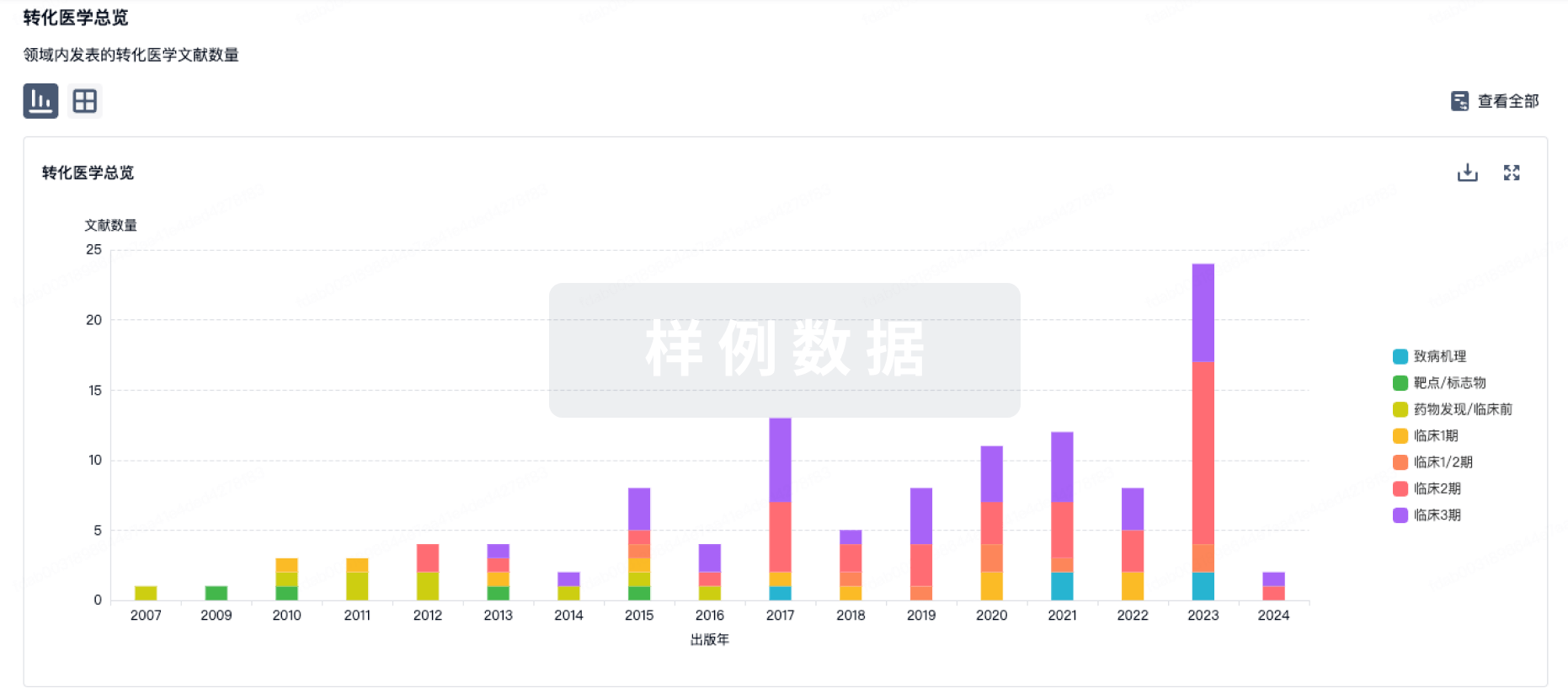
药物交易
使用我们的药物交易数据加速您的研究。
登录
或
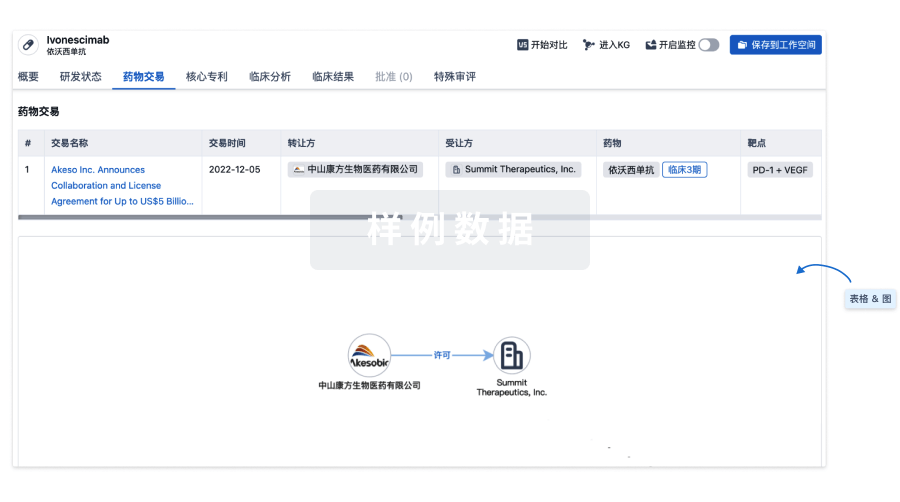
核心专利
使用我们的核心专利数据促进您的研究。
登录
或

临床分析
紧跟全球注册中心的最新临床试验。
登录
或
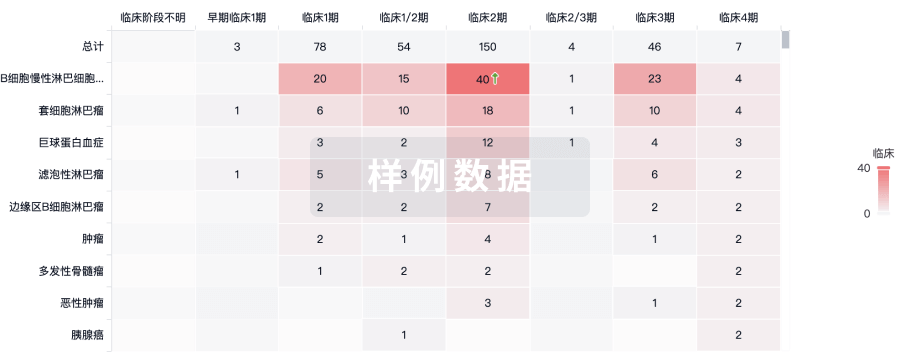
批准
利用最新的监管批准信息加速您的研究。
登录
或
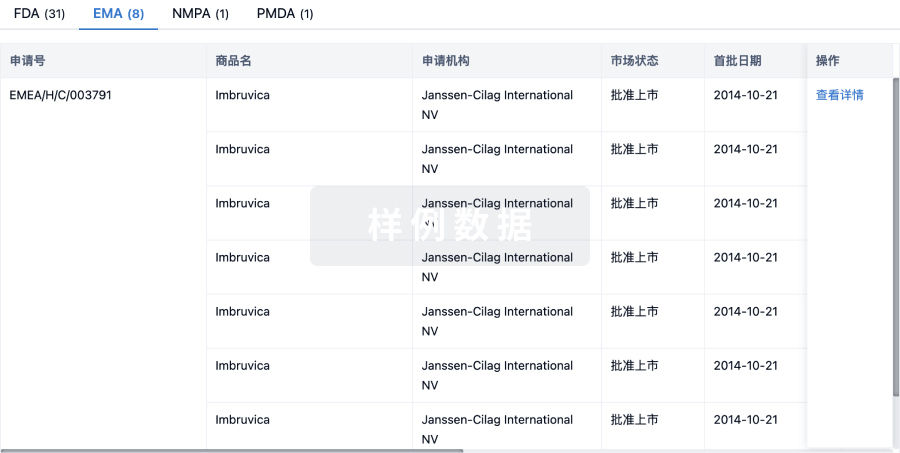
特殊审评
只需点击几下即可了解关键药物信息。
登录
或
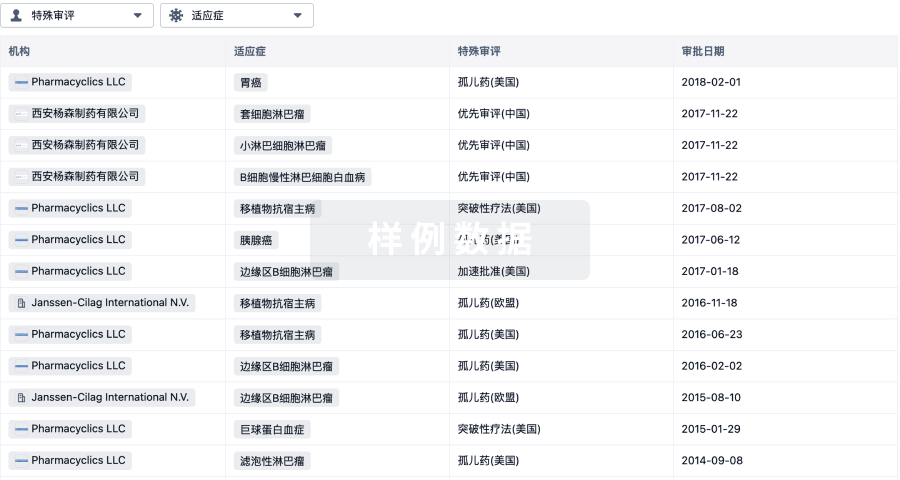
生物医药百科问答
全新生物医药AI Agent 覆盖科研全链路,让突破性发现快人一步
立即开始免费试用!
智慧芽新药情报库是智慧芽专为生命科学人士构建的基于AI的创新药情报平台,助您全方位提升您的研发与决策效率。
立即开始数据试用!
智慧芽新药库数据也通过智慧芽数据服务平台,以API或者数据包形式对外开放,助您更加充分利用智慧芽新药情报信息。
生物序列数据库
生物药研发创新
免费使用
化学结构数据库
小分子化药研发创新
免费使用


